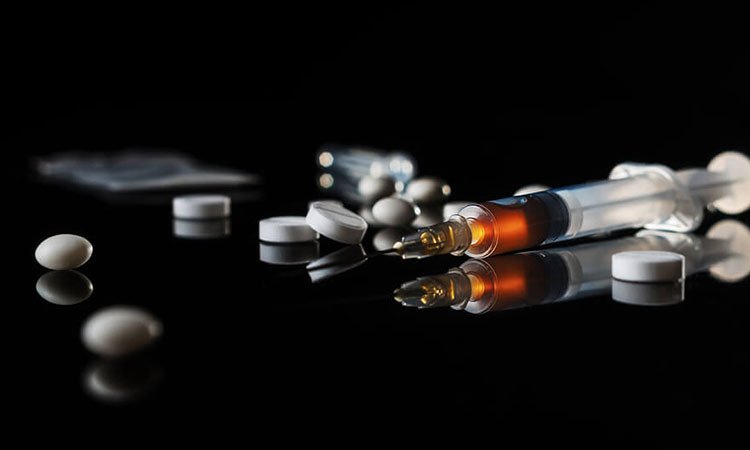
Types of Drugs – Psychoactive drugs can be found in a broad range of forms and can be administered in a variety of ways. They can also fluctuate widely in both their properties and effects. Rather than being classified as merely prescription versus illicit, it is far more helpful to categorize drugs based on their properties and the effects they invoke.
While at the core, science recognizes just three main types of drugs – stimulants, depressants, and hallucinogens – there are also a few “subcategories” that can be helpful in defining the exact nature of certain psychoactive substances, particularly those which exhibit the effects of more than just one type of drug.
For example, MDMA (Molly, Ecstasy) has properties that induce both stimulating effects and hallucinations/altered perceptions. While technically, MDMA is considered to be a stimulant, some experts have argued that the drug deserves a category unto itself.
The following are seven different types of drugs, based on the above proposition:
- Depressants
- Opioids
- Stimulants
- Anabolic steroids
- Hallucinogens
- Dissociatives
- Inhalants
Types of Drugs – Stimulants

Stimulants, also known as uppers, increase activity in the central nervous system (CNS) and “speed up” many bodily systems. Use can result in significant increases in energy, alertness, concentration, heart rate, blood pressure, and breathing.
Prescription stimulants, such as Adderall and Ritalin, are most often prescribed for attention-deficit hyperactivity disorder, narcolepsy, and to a lesser extent, asthma. They can also aid in appetite suppression and weight loss. They typically come in pill form, but for abuse purposes, they can be crushed and snorted for faster delivery and more intense effects.
Illicit stimulants include cocaine, meth, and Ecstasy. Unlike prescription stimulants, cocaine and meth most often present as a whitish powder or rock-like substance. Cocaine is usually snorted and meth is frequently smoked, although there are multiple methods of administration can be used for either substance.
As noted below, anabolic steroids also cause stimulating effects, but the mechanism of action is entirely different from say, amphetamines such as Adderall or meth.
Examples of stimulants include:
- Adderall
- Ritalin
- Cocaine
- Methamphetamine
- Ecstasy
- Synthetic Marijuana
Risks of Stimulant Abuse
- Anxiety
- Paranoia
- High body temperature (hyperthermia)
- Depression
- Psychosis
- Heart failure
- Stroke
- Seizures
Types of Drugs – Depressants

As opposed to stimulants, depressants decrease activity in the CNS. For this reason, they are often referred to as downers and can invoke relaxation, calm, and sedation.
Depressants are frequently prescribed by doctors for anxiety and insomnia (e.g., benzodiazepines), pain (e.g. opioids), and other conditions that benefit from reduced central nervous system activity. Depressants can also invoke heavy sedation, and are employed in clinical settings for general anesthesia.
Alcohol is a depressant that is easily obtained without a prescription.
Examples of depressants include the following:
- Alcohol – initial effects may feel stimulating due to increased dopamine but the end result from excessive use is CNS depression
- Cannabis*
- Benzodiazepines such as Xanax
- GHB
- Barbituates
- Sedative-hypnotics such as Ambien
*Cannabis is considered to be a depressant, although mild hallucinations are not uncommong and certain strains can have stimulating effects. Also, it is dubious that cannabis has the addictive potential of other CNS depressants, such as benzodiazepines.
Risks of Depressant Abuse
Depressants are particularly dangerous when combined with other drugs, including other CNS depressants, stimulants, and opioids.
- Increased risk of high blood sugar and diabetes
- Weight gain
- Increased body temperature
- Delirium
- Sluggish thinking
- Low blood pressure
- Impaired memory
- Hallucinations
- Slowed heartbeat and respiration
- Death from withdrawal
Types of Drugs – Opioids
Opioids and opiates are powerful analgesics (painkillers) that can also produce a sense of euphoria in users. Opiates are naturally occurring in opium poppy plants, such as codeine and morphine, and opioids are synthesized (human-made) in a lab.
Because opioids and opiates function nearly identically, for the purposes of this article, from this point on both forms will be referred to interchangeably.
Opioids are powerful painkillers that produce a sense of euphoria in users. In addition to offering pain relief, they work on the brain’s reward center and increase chemical neurotransmitters (e.g., dopamine and serotonin) responsible for feelings of well-being.
For this reason, opioids are very addictive and a high potential for abuse and dependency. Opioids can be consumed in several ways, including oral ingestion, inhalation, and injection.
Examples of opiates/opioids include:
- Opium
- Codeine (Tylenol 3)
- Morphine
- Heroin
- Fentanyl
- Hydrocodone (Norco)
- Oxycodone (Oxycontin, Percocet)
- Hydromorphone (Dilaudid)
Risks of Opioid Abuse
Opioid abuse or addiction can result in devastating effects on a person’s health and mental and emotional well-being. Withdrawal symptoms (also known as being “dope sick” are highly unpleasant and are often the catalyst for relapse.
Side effects of opioid abuse may include the following:
- Constipation
- Liver damage
- Brain impairment
- Euphoria
- Drowsiness
- Sedation
- Pupil dilation
Opioids are also notorious for their potential for overdose, which is a life-threatening emergency. Effects of an overdose include the following:
- Vomiting
- Cyanosis (bluish or purple skin)
- Labored, slowed, or stopped breathing
- Unconsciousness/unresponsiveness
- Respiratory arrest
- Coma
- Death
Types of Drugs – Hallucinogens
Hallucinogens are substances that interfere with the usual course of communication in the brain. Users can experience intense emotions, visual and auditory disturbances, and altered perceptions of objects, people, places, space and time.
Hallucinogens come in many forms, and can be smoked, eaten, taken as tablets or capsules and made into tea-like beverages or added to alcohol.
- LSD
- DMT (e.g. ayahuasca)
- Psilocybin (mushrooms)
- Salvia
- Peyote
Risks of Hallucinogen Abuse
According to users, many of these experiences are considered enjoyable and even spiritual – however, anxiety and panic can also manifest rapidly, possibly resulting in psychological trauma.
- Hallucinogen Persisting Perception Disorder (HPPD), also known as flashbacks
- Fear
- Distorted cognition
- Paranoia
- Psychosis
- Anxiety
- Increased blood pressure
- Nausea
Types of Drugs – Dissociatives

For practical purposes, dissociative drugs fall under the category of hallucinogens, but do have properties and effects that set them apart from say, LSD or mushrooms. They can be quite dangerous and lead people into hazardous situations.
Dissociatives distort the user’s perception of reality, and as the name implies, causes them to dissociate from their own body. As a result, they may develop delusions, such as being invincible and therefore engage in risky and impulsive behaviors that they would not otherwise.
Dissociatives work by disrupting the link between the brain’s receptors and glutamate, a chemical that plays an essential role in cognition, emotions, and the perception of pain. Effects can also include sensory deprivation, hallucinations, and dream-like states or trances.
Dissociatives can be consumed as liquids, powders, solids or gases. Examples include the following:
- Ketamine
- DXM (Dextromethorphan)
- PCP (phencyclidine)
- Nitrous oxide (also an inhalant)
- Chloroform (also an inhalant)
Risks of Dissociative Drug Abuse
Using dissociative drugs illictly can be risky and can result in serious injury and/or psychological trauma.
- Depression
- Anxiety
- Suicidal thoughts
- Speech difficulties
- Social withdrawal
- Hallucinations
- Detachment from reality
- Numbness
- Memory loss
Types of Drugs – Inhalants
Inhalants include many common household items, such as whipped cream cans, that contain gases or fumes. Inhaling or “huffing” these fumes can result in brief bouts of euphoria
Examples of inhalants include:
- Fumes of markers, glue, paint, paint thinner, and gasoline
- Nitrous oxide
- Aerosol spray cans
- Room deodorizers
- Canned air dusters
Risks of Inhalant Drug Abuse
- Loss of smell
- Brain damage
- Nosebleeds
- Weakness
- Increased heart rate
- Loss of consciousness
- Hallucinations
- Slurred speech
Types of Drugs – Anabolic Steroids
Anabolic steroids are often used by athletes and bodybuilders to enlarge muscles and increase physical performance and strength. While steroid use may invoke stimulating effects (e.g. increased energy) they are not stimulants in the same sense as amphetamines or cocaine. Most steroids function to increase testosterone in the body rather than merely increase activity in the CNS.
Types of anabolic steroid drugs include:
- Anadrol
- Oxandrin
- Durabolin
- Stanozol
- Dianabol
Risks of Anabolic Drug Abuse
- Severe acne, oily skin and hair
- Hair loss
- Kidney or liver disease
- Heart disease, such as heart attack and stroke
- Altered mood, irritability, and increased aggression
- Depression or suicidal tendencies
- Adverse changes in cholesterol and other blood lipids
- Hypertension
- Gynecomastia (breast enlargement in men)
- Shrinking of testicles
- Lowered sperm count
- Menstrual irregularities in women
- Infertility
- Excess facial/body hair, deeper voice in women
- Stunted growth/height in teens
- Risk of viral or bacterial infections due to unsterile injections
Treatment for Drug Addiction
Most people seeking addiction treatment begin with a medical detox, which usually takes place in a hospital or treatment center. After detox, patients are referred to either inpatient or intensive outpatient treatment, where they can participate in therapy, counseling, and recovery-promoting activities.
After treatment has been completed, former patients receive aftercare planning services that help him or her identify resources outside of the center for long-term support and ongoing therapy
Our programs are structured with various components of evidence-based treatment practices and holistic approaches to treatment that provide our patients with the knowledge and tools they need to be successful in their recovery.
If you or your loved one is suffering from substance abuse, please seek help as soon as possible.